Autonomous power supply for a private home: review of the best local solutions
The installation of an independent electrical system will provide energy to private buildings not connected to centralized networks. The result will help reduce the energy costs of cottages and houses.But in order to take advantage of the listed advantages, you need to know exactly how to make an autonomous power supply for a private home. Isn't it true?
We will talk about the design of independent power supply systems. Here you will find the fundamental principles of the device and important nuances of organizing the supply of electricity to private residential properties. The information we provide is carefully checked, systematized, and the information complies with building regulations.
In the article we propose, the options for constructing private energy systems are thoroughly analyzed, all possible sources of energy are presented and evaluated. The principles of construction and operation of an autonomous power supply are described in detail, the presented data is supported by photos and videos.
The content of the article:
- General requirements for home autonomous systems
- Weighted assessment of an independent system
- Determining the Best Energy Source
- Features of generators
- Autonomous solar power plants
- Wind energy for autonomous power supply
- Local hydropower systems
- Batteries for autonomous systems
- Conclusions and useful video on the topic
General requirements for home autonomous systems
In order for the autonomous complex to work correctly and produce a volume of energy that fully covers the needs of all home devices and household appliances, before installing the equipment, a preliminary calculation of the total power of available electrical consumers is carried out.
These include units such as:
- heating system of a residential building;
- refrigeration equipment;
- air purification/cooling devices;
- large and small-sized household appliances;
- a pumping complex that supplies water to the house from a well or borehole;
- electric tool for do-it-yourself routine repairs and maintenance of buildings and garden plots.
The basic power is learned from the accompanying documents issued by the manufacturer and attached to each unit. This indicator is different for everyone, but any devices and devices equally require a stable supply of energy with a certain frequency of electrical flow and without voltage drops.
In some cases, such a parameter as the sinusoidal shape of the alternating voltage is also taken into account.
Data on the power of devices is summarized and in this way it is found out how many real kilowatt hours an autonomous electrical system should uninterruptedly produce per day. It is recommended to exceed the obtained number by 15-30% in order to have a solid reserve for increasing energy consumption in the future.
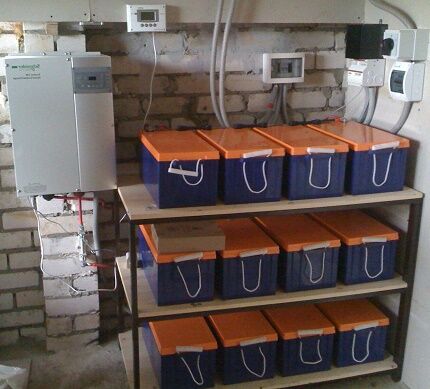
At the next stage, the main technical characteristics of the future energy system are determined. These parameters directly depend on its purpose.
When planning to make a backup source that connects only at a certain moment, when receiving electricity through centralized communications is not available, the estimated operating time of the autonomous equipment is established, and based on these data, the power required for the normal functioning of the system is calculated.
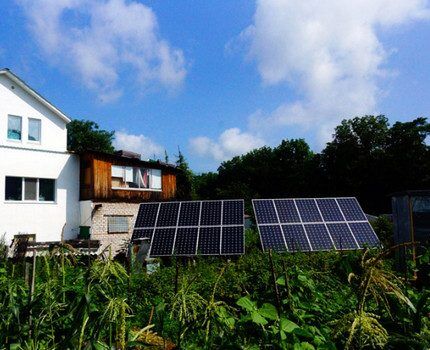
If they plan to rely on the “shoulders” of autonomous equipment for all the electricity supply in a residential building, outbuildings and on the plot itself, they clearly calculate the approximate daily consumption in advance.
Another 20-25% is added to this figure and in this way the actual base power necessary for the full operation of communication networks, equipment and household appliances is obtained.
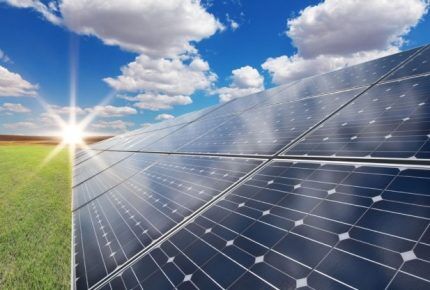
Having detailed technical information in hand, they begin to develop the project and produce an estimate with a complete objective calculation of the upcoming financial costs for the purchase of units and payment for installation services.
Specialists, of course, will handle the installation faster and with better quality, but they will ask for a substantial amount of money for it. Home craftsmen can also master the main parts of the task, but to carry out individual stages it would still be wiser to invite professionals or at least take their advice.
Weighted assessment of an independent system
Modern systems for autonomous power supply use a variety of resources to generate energy. This allows you to receive high-quality electricity without fluctuations even in the most remote and sparsely populated places, where all the benefits of civilization have not yet reached.
Advantages of autonomous electrics
The main advantage of autonomous power supply systems is the absence of consumption standards and fees for used energy. This allows you to provide any level of comfort in a residential building, regardless of whether there are central communications nearby or not.
If the preliminary power calculations are made correctly and are not underestimated, the system will work like clockwork and the owners will not encounter problems such as unexpected power outages and voltage surges.

The risk that household appliances in your home will fail or burn out due to an unexpected power surge will be reduced to zero. The quantity and quality of electricity received will always be the same and exactly as was originally planned in the project.
Equipment that provides independent supplies of electricity has a high level of reliability and rarely fails. This advantage remains relevant if basic operating rules and regular maintenance of individual elements and the entire system are observed.
In addition, pilot programs are already operating today that allow owners to sell excess electricity to the state. However, it is worth thinking about using this interesting opportunity in advance, even at the stage of developing a power supply system project.
Additionally, you will need to issue a package of permits confirming the ability of the available devices to generate the required amount of energy of appropriate quality.
Disadvantages of an independent power supply
The disadvantages of an independent power supply system include the rather high cost of equipment and significant operating costs.
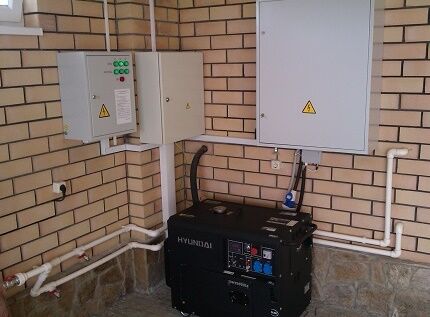
Electricians strongly recommend that owners make all calculations very carefully and clearly clarify the technical parameters of the system planned for installation. Otherwise, a situation may arise when the unit producing electricity fails without having time to pay for itself.
The owners also carry out repairs to the autonomous complex at their own expense, and these services cost a significant amount of money. If the house is located in a remote or hard-to-reach area, you will have to go to the craftsmen personally or additionally pay for the team to go to the site.
Moreover, everything will need to be done quite quickly, since home communications and amenities that run on electricity will be unavailable at this time.
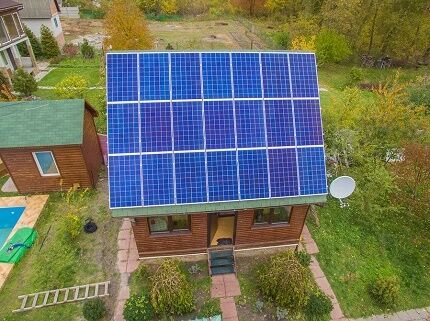
Regular preventive inspection and scheduled maintenance of operating units will significantly reduce the chance of breakdown of autonomous devices, but this may also require a visit from specialists, which costs money.
Of course, the owner will do some of this work himself, but more serious issues that require certain experience and specific knowledge will still entail professional intervention.
Determining the Best Energy Source
Choosing an alternative energy source for autonomous electrical supply of a residential building – a very important and responsible moment that requires a serious approach.
The most popular and most common options include:
- generators running on diesel fuel or gasoline;
- solar panels;
- batteries of large volume and power;
- hydroelectric systems;
- wind energy converters.
Each source has its own unique characteristics and features. Owners should familiarize themselves with them in advance and, based on this information, determine the best option for a system that can satisfy all the electrical needs of a private residential building.
Features of generators
A generator is the fastest and easiest way to provide a private home with electricity. To operate, the unit uses gasoline or diesel fuel and, as a result of its combustion, produces the required amount of energy.
The main advantage is the complete independence of the device from seasonal changes and weather fluctuations. The disadvantages include the mandatory presence on site of a specially equipped fuel storage facility designed for a volume of 200 liters or more.
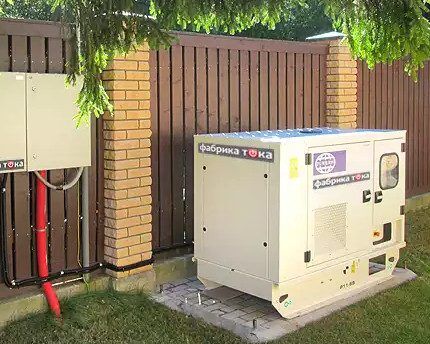
Most often, gasoline and diesel generator sets are used as backup or temporary sources of electricity.This is due to the fact that for full operation the devices require significant amounts of fuel, the cost of which is constantly increasing.
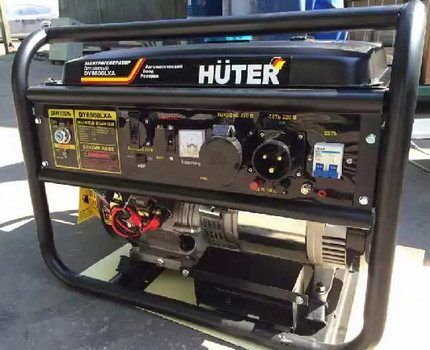
The equipment itself is also expensive and requires preventive maintenance. More profitable options for generator sets include gas units. They do not require an uninterrupted supply of fuel and do not require storage for fuel materials.
However, the full operation of these devices is ensured by such a point as a mandatory connection to the central gas network, which is not always possible and affordable.
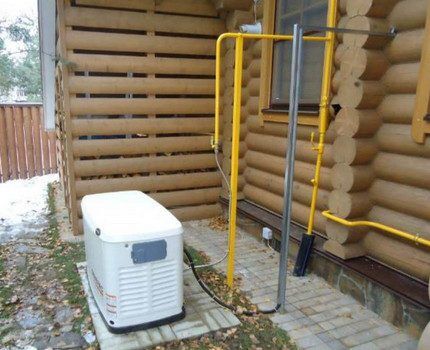
It is because of these difficulties that generators are rarely chosen as the main source of supplying electricity to a private home.
But generators are an ideal solution for temporary use, for example, during the construction of a country house and the preparation of documents for its connection:
During the first stages of construction, the generator will serve as the main source of energy, and after paperwork is completed and permission to connect to the general power grid is obtained, it will become backup equipment and will certainly come in handy more than once.
Autonomous solar power plants
To supply a private residential building, collectors or solar panels. These devices absorb light energy and convert it into current, which then powers systems, devices and appliances that run on electricity.
Solar batteries (panels) are a set of semiconductor elements connected together and enclosed in a frame that convert light resources into electrical energy.The equipment does not consume fuel and does not require complex, highly professional maintenance.
To keep the object in order, it is enough to simply wipe the absorbing mirror from dust from time to time and remove small debris from it. Installing the unit at a certain elevation at an angle of about 70 degrees will create conditions under which, in winter, snow will not be able to accumulate on the surface of the battery and interfere with its correct operation.
The solar system is adjusted automatically. The owner does not need to turn the equipment on or off. The generated energy is accumulated in special battery complexes and allows you to use electricity around the clock in an individual mode that is convenient for the owner.

High quality solar panels are very reliable and are designed for full operation for at least 25 years. By the end of this period, their performance decreases slightly and for the next 20 years the panels provide a resource of about 80% of the basic initial power declared by the manufacturer.
Thus, the total battery life is 45 years, which significantly exceeds other autonomous systems.
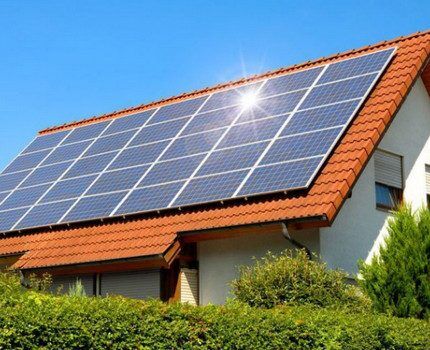
Since sunlight is available almost everywhere, solar panels have almost no restrictions on installation. They can be placed on any unshaded space of the site, turning the receiving surface at a certain angle to the south side.

If the size of the garden area does not allow you to allocate a separate free space for the equipment, it is appropriate to use the roof surface of a residential building or the roof of outbuildings for installation of the system.
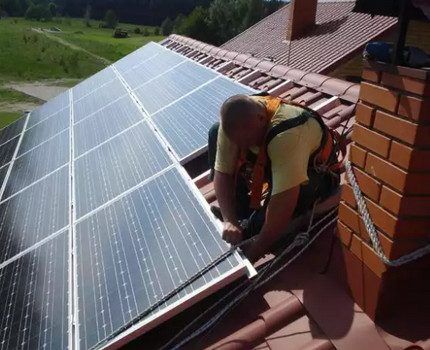
Wind and hydroelectric systems have a fixed power level. For solar systems, this value is floating and depends only on the number of installed batteries. Solar panels can be used as additional energy sources. In this case you will need hybrid inverter, which our recommended article will introduce you to.
If there is no need for a large amount of energy at the moment, you can install a unit of miniature dimensions, and if necessary, at a convenient time, add additional panels and increase the amount of resource received.
Wind energy for autonomous power supply
In the event that meteorological or any other objective reasons do not allow the installation of solar panels or collectors, it makes sense to pay attention to wind generator assembly and installation. It is a turbine placed on high (from 3 meters) towers.
It captures the kinetic energy of the vortex flow, converts it into mechanical energy by rotating the rotor, and then turns it into an electrical resource using special inverters.
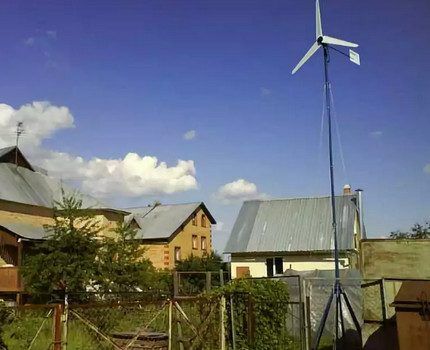
Statistics can be provided by the weather service and various Internet services that allow you to monitor the weather online. If the winds in the region are considered a rare phenomenon and do not have the required strength, installing a “wind turbine” will be impractical.
The unit is reliable, wind generator does not create harmful emissions into the atmosphere and does not leave production waste, but for full operation it urgently needs a constant wind blowing at a speed of at least 14 kilometers per hour. This is a very important condition, and if it is not met, the device simply will not cope with the assigned tasks.
Local hydropower systems
Using a hydraulic turbine to supply a residential building with electricity is a very realistic and profitable option, but only if there is a river or lake near the buildings. A small system powered by water energy is absolutely safe both environmentally and socially, is very easy to operate and has good efficiency.
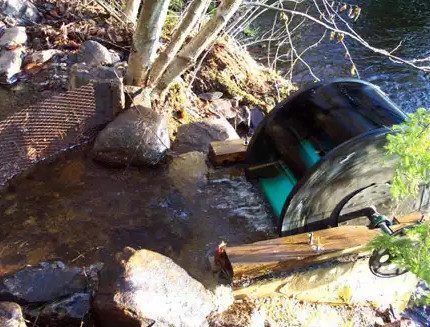
Duration of full-time work miniature hydroelectric power station exceeds 40 years. For correct functioning, the system does not require large reservoirs and does not require flooding of large areas.
Before installation, it is necessary to draw up an installation project and obtain the appropriate permits.
Batteries for autonomous systems
The principle of operation of the battery is clear and simple. As long as there is electricity in the central network, the batteries are charged from the outlet and accumulate resource in their blocks. Batteries for solar panels function in a similar way.
When energy supplies are interrupted, the modules, through a special inverter installation provide electrical services to household appliances and various home systems.
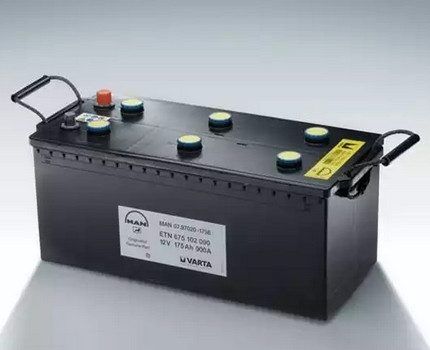
They are not suitable for constantly providing a living space with electricity, but they will cope with the role of a backup complex perfectly.
He will introduce you to the best developments for organizing alternative energy in a country house. next article, entirely devoted to this interesting issue.
Conclusions and useful video on the topic
Video No. 1 will clearly demonstrate how to assemble an autonomous power supply system for a private home using solar panels with your own hands. The video provides useful tips from the master with a detailed demonstration of each action and a description of the equipment used:
Video #2 introduces what you should choose to create a backup electrical system in your home: a generator or a battery. An overview of the units, pros and cons, comparative characteristics and principles of operation will help independent craftsmen in implementing the idea:
Video No. 3 presents how a wind generator works and whether it is capable of covering all the electricity needs of an average residential building:
Video No. 4 presents an independent power supply complex for a country house using various resources and installations. The advantages and disadvantages of a system of solar panels, a MAP inverter and a progressive wind generator are outlined:
The need to organize autonomous electricity for a private home may arise for various reasons, for example, due to the difficulty of connecting to an existing network or due to the lack of central communications in the area where the housing is located.
Unstable voltage, power outages or regular shutdowns can also force property owners to think about obtaining energy from alternative sources. A correctly calculated and correctly installed system will allow you to forget about all electrical problems.
Tell us about how you built an autonomous energy supply system on a suburban site. It is possible that you have methods in your arsenal that are not listed in the article, and information that is useful for site visitors.Please write comments in the block below, share your impressions, post photos, ask questions.




In fact, an autonomous power supply system for the home is very useful. We often have power outages. The only thing we can afford are electric generators of various capacities, but such a thing as solar panels that convert solar energy into electrical energy is a very distant prospect for us. I would even say, not in our life. In Europe this has been happening for a long time, but it hasn’t reached us yet and whether it will reach us.
I think solar panels have a promising future. Purchase and installation are still expensive, but they will quickly pay for themselves. Naturally, devices also require care. An acquaintance installed several of these squares for the sake of testing, so far he is not complaining, but he does not plan to give up paid electricity. The main thing is to install them correctly, on the right side, where they will be most effective.
Taking into account current electricity prices, an autonomous power supply system would be very effective and useful on the farm. It is a pity that installing such batteries requires considerable expense, plus additional costs for maintaining the system. Although I know people who have several units installed in their dachas, they also actively use ordinary electricity. Perhaps in a few years our people will begin to use such systems more actively, because it is really beneficial.
Nikolay, the prices are just right. There are no special problems - our electricity is not that expensive. The problem is that it is not available everywhere.For example, in a remote village where there are only a couple of residential houses left, no one will especially watch this. If a pole falls somewhere, it’s not a fact that it will be restored quickly (if they do it at all). Well, interruptions - we need to deal with them somehow.
The most promising options for autonomous integrated energy supply can ensure uninterrupted supply of a private facility with both hot sanitary water and the electricity required to operate household appliances.
What are the most promising options?
And this already depends on the geographical location and climatic characteristics of the area. For example, solar panels will be relevant in the south, and a wind generator in mid-latitudes. But you can also combine it - install solar panels plus a wind generator. The latter is relevant if there are a lot of windy days and the speed of the currents also matters.
As for the use of hydraulic turbines, not everyone has a fast river or stream flowing near their site. In addition, it is not always possible to build a hydroelectric generator without a dam, which means additional permits.
The use of gasoline or diesel autonomous generators is completely justified, since alternative energy sources may fail.
Therefore, the most promising options for an autonomous integrated energy supply are solar panels and wind generators, plus gasoline or diesel autonomous generators.
The topic is interesting and in demand. Only our government, under the leadership of the largest resource extraction and processing magnates, will not give complete carte blanche for the transition to alternative energy sources.
“Money rules the world and the one who has more of it is stronger”®
How many of the greatest minds have disappeared into obscurity, how many were found dead immediately after the promulgation of technologies that would have turned history and the entire production of any resource upside down... You don’t need to go far for an example - hydrogen engines, water-powered engines, engines that consume fuel ten times less with higher power output, biofuel engines, etc. This is not beneficial for the most influential people in this world and therefore it will be suppressed in every possible way - murders, unaffordable prices, “inexplicable” lack of demand, etc....
Well, by the way, I cover a considerable part even in winter and autumn with a storage battery. Of course, not everything, 7 panels for a house of 250 square meters turned out to be not enough, but the savings are noticeable.
Well, by the way, I cover a considerable part even in winter and autumn with a volts storage battery. Of course, not everything, 7 panels for a house of 250 square meters turned out to be not enough, but the savings are noticeable.
Energy must be stored in charcoal. It doesn't spoil. And due to the buffer capacity of the most inexpensive batteries, it can cover peak loads, as in this video:
https://youtube.com/shorts/fuuJCRe3hEA?feature=share